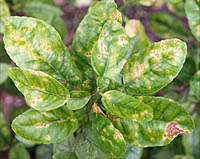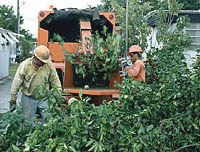We have always been told how Vitamin C from oranges is good for us; drink orange juice when you have a cold, etc. But now those same oranges are under attack in Florida. Citrus canker, caused by a bacterium called
Xanthomonas axonopodis
pv. citri, once again began to march through the citrus growing areas of Florida. This time though citrus canker is causing problems beyond the commercial growing areas as it has entered the backyards of many residents.
But what exactly is citrus canker? Citrus canker is a bacterial plant disease that is not harmful to humans or animals. The disease causes the fruit (oranges, lemons, limes, grapefruits, etc) to drop early. While
 citrus canker does not affect the juice inside the fruit (the industry's primary product), it does cause lesions on the fruit and leaves and it reduces harvest. It could also restrict the state in exporting oranges because counties within Florida and other states which do not have citrus canker could refuse entry of Florida fruit from citrus canker infected areas.
citrus canker does not affect the juice inside the fruit (the industry's primary product), it does cause lesions on the fruit and leaves and it reduces harvest. It could also restrict the state in exporting oranges because counties within Florida and other states which do not have citrus canker could refuse entry of Florida fruit from citrus canker infected areas.
This is not the first time Florida must deal with citrus canker. In 1933, Florida declared that citrus canker was eradicated after more than 258,000 grove trees and 3 million nursery trees were destroyed. Quarantines were instituted in an effort to keep Florida free from citrus canker. But citrus canker returned. Between 1986 and 1992, citrus canker was discovered in 13 locations in Florida. By 1994, Florida once again declared that citrus canker had been eradicated after the utilization of a strict eradication program. In June 1997, citrus canker was discovered once again in commercial groves in Manatee County, FL.
The dilemma facing Florida is that the tactic being utilized and deemed necessary to once again stop the spread and to eradicate citrus canker is being met with some opposition. Citrus canker is spread by wind, rain, and animals, even people who can carry the
 bacteria on hands, clothing, or garden tools. To reduce the spread, all citrus trees, whether healthy or not, that are located with 1,900 feet of an infected citrus tree are being destroyed. Florida officials estimate that one-third of the 2.5 million backyard citrus trees in South Florida will be destroyed. More than 500,000 residential trees have already been destroyed. Many residents are complaining about removal of the trees and the manner in which trees are being removed. The November 3, 2000 issue of USA Today ran a picture of a resident marching with a sign that read "Stop the Citrus Gestapo!".
bacteria on hands, clothing, or garden tools. To reduce the spread, all citrus trees, whether healthy or not, that are located with 1,900 feet of an infected citrus tree are being destroyed. Florida officials estimate that one-third of the 2.5 million backyard citrus trees in South Florida will be destroyed. More than 500,000 residential trees have already been destroyed. Many residents are complaining about removal of the trees and the manner in which trees are being removed. The November 3, 2000 issue of USA Today ran a picture of a resident marching with a sign that read "Stop the Citrus Gestapo!".
Residents are not the only ones falling victim in the war on citrus canker. Commercial growers are being hit pretty hard. Florida's citrus industry is the main component of the states agriculture. With more
 than 140,000 employees it is second only to tourism in economic impact on Florida's economy. Commercial growers have already lost more than 1.2 million citrus trees in commercial groves in south Miami. Four other counties have already destroyed their citrus trees. About $100 million worth of commercial trees have been lost and growers have had to spend more than $25 million to set up decontamination stations.
than 140,000 employees it is second only to tourism in economic impact on Florida's economy. Commercial growers have already lost more than 1.2 million citrus trees in commercial groves in south Miami. Four other counties have already destroyed their citrus trees. About $100 million worth of commercial trees have been lost and growers have had to spend more than $25 million to set up decontamination stations.
While the officials are trying desperately to prevent citrus canker from becoming devastating to their citrus industry, many residents are feeling violated. Should the residents be allowed to keep the trees many planted themselves? According the same USA Today article "state officials say the drastic measure are necessary to stop the spread of canker, which now is concentrated mostly to South Florida. The disease not only threatens an $8.5-billion-a-year citrus industry, agricultural officials say, but also the future of the fruit in a sate where backyard orange trees are as symbolic as Florida sunshine."
For more information on this serious disease see: Citrus Canker
 |
Views: Stem-end rot of mango caused by Cytosphaera mangiferae. The lesions such as the one illustrated develop slowly and render infected fruits inedible. In the advanced stages of rot, fruiting bodies (specialized structures that contain spores) of the fungus may appear at the stem end. These fruiting bodies are one way in which the pathogen survives between growing seasons. (Courtesy A.W. Cooke) |
